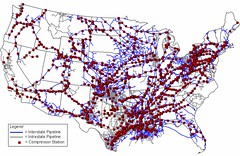A Personal Testimony
by Michael Morrill
reported on Daily Kos
Mon Jun 07, 2010
An explosion at a natural gas well in northwest Pennsylvania resulted in a spill of at least a million gallons of oil and chemicals mixed with water. According to the AP report, there was a shower of gas and chemical-laden water shooting 75 feet into the air. The leak continued for at least 16 hours. The accident was so severe that the area was evacuated and the Federal Aviation Administration prohibited flights in the area.
When I heard of the accident on Friday afternoon, I immediately left the meeting I was attending in Washington, DC and headed for the site with my trusty Flip Camera in hand.
So where are the photos and video showing the extent of the pollution?
They don’t exist, because EOG Resources, the owner of the wells, won’t allow anyone on the site, especially with a camera. When I tried to shoot some video, they not only wouldn’t let me on the site, they told me I might be shot for being on their property and then sent thugs to chase me and threaten me.
Link to Michael Morrill's Daily Kos diary I arrived around 7:30 PM and drove around the area trying to find the site. I asked a number of locals if they knew the site of the explosion. No one knew what I was talking about, so it wasn’t until about 9:00 that I finally stumbled upon the site. It’s about 5 ½ miles from the entrance to S.B. Elliott State Park in Clearfield County.
As I approached the site a man got out of a pickup truck and told me I would have to leave. I told him I just wanted to get some video of the cleanup. He said he couldn’t allow me on the grounds and I didn’t leave right away I would be arrested for trespassing.
In the morning I tried again and got the same answer from another man in a pickup truck.
I could see through the forest that there was work going on in the distance, but my little flip Camera couldn’t get anything but trees. I decided that maybe a hike through the woods was in order, so I drove a few miles to a point on the other side of the spill site. I chose an entrance point that was not marked as private property and hiked toward the site.
Along the way I saw still and flowing water with oily residue. Some of it may be from the spill, but most of it was uphill from the accident site. That means the water in this area is likely contaminated from the numerous gas wells being drilled.
I found a road on a ridge that appeared to head close to the accident site and walked about a half mile on that road when I was stopped by two men in a Gator. They asked me what I was doing out there and I said I was just taking a hike. They told me that I was on property owned by the Punxsutawney Hunt Club and the members didn’t appreciate trespassers. They told me, in a veiled threat, that I should leave now and as long as I was heading out I would probably not get shot.
I’m not one to back down easily, but I wasn’t ready to take a bullet for a grainy video of the spill site. I wished them a good day and turned back to my car, a couple of miles and bridgeless brook away. As I crossed the brook barefoot I noticed another pickup truck parking on the opposite hill, blocking the path. When I approached the truck two men got out. The older man got in front of me and said “Show me some ID.”
I asked him who he was and he grabbed my arm and told me I was on private property. I shook his hand off and continued walking. Without looking back, I told him there was nothing posted that indicated the land I was on was private property. He yelled to me, “We know where your car is. We called the police. You’ll be arrested when you get back to your car.” He then added, “We know you’re taking water samples.”
The truth is, I had filled up some drinking water bottles with samples of water from various sites along my hike. I’m not sure what use they will be, but I thought it was important to at least get something that could be independently tested.
When I got a few hundred yards from my car I could hear the last two men who confronted me. As I approached my car the older man took out an old disposable film camera and took my picture. I tried to get my Flip Camera to take some video of them, but the battery was dead and I only got a few seconds.
They tried to get me to stay and wait for the police to come, but I wasn’t about to test the fairness of the local criminal justice system. I told them to back off or be charged with assault, and susprisingly they complied.
As a parting shot the younger one said,” Don’t come back.” I replied, childishly, “I’ll do what I want.” He said, “If you come back you won’t leave.”
I got in my car and started to leave the way I came in. They passed me and I drove a safe distance behind them. Then I realized that I may be driving into a trap. When they turned a corner toward the spill site, I stopped and turned around. I drove a few miles in the wrong direction, but eventually found a connection to Route 153. And then home.
I have some video that I’ll be posting later today and tomorrow. It’s not very expository, but it’s all I could get. I’ll also be trying to find an independent lab that can identify the chemicals and oily residue in the water samples I took. I’ll post the results of those tests as I get them.
In the meantime, it’s important for the public to know what’s really going on at the spill site.
There has been very little news coverage of this major accident and part of the reason is the lack of access to the site. It’s hard to report when you have no information. It’s harder when the perpetrators are in full control of what little information has been released. “Nothing to see here,” EOG Resources assures us. “It was only a million gallons and we took care of it.”
If that’s the truth, it’s a huge accident that threatens local waterways that flow into the Susquehanna River and Chesapeake Bay. But what if it’s worse than that? We don’t know because there are no independent eyes and ears on the site. Haven’t we learned yet that we should never rely on the word of the people who caused the problem?
I’m calling on Governor Ed Rendell and Department of Environmental Protection Secretary John Hanger to use their offices to grant access to the spill site to the media, environmental organizations and the local population. It’s probably too late to see anything damning, but it will at least give us a picture of where the accident occurred so we can begin to ask the right questions and make sure any investigations are accurate and complete.
DEMAND ACCOUNTABILITY!




















